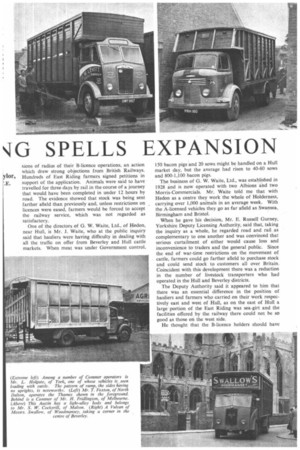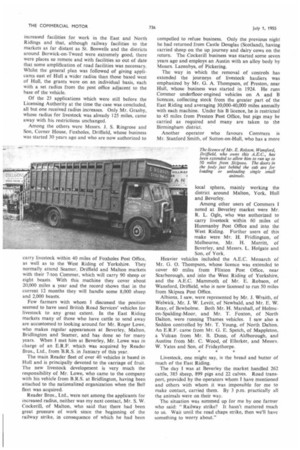FREE TRAD ■ IG SPELLS EXPANSION
Page 70

Page 71

Page 72

If you've noticed an error in this article please click here to report it so we can fix it.
ATthe cattle market in the ancient borough of Beverley the visitor may fix himself up with a pair of boots, a rainproof, potted plants, or even a used lorry. If he forms part of that busy scene, however, any such transaction will almost certainly be a side issue, for the primary interest of those who penetrate to the market ground is almost always the buying, selling or carrying of livestock. Here will be seen the familiar figures who, as the days roll by, are _ also encountered at the other livestock markets in East Yorkshire—at Hull, 'Driffield, Malton, Bridlington, Seamer and Pickering.
When I was in Beverley last month, livestock hauliers from the East Riding villages with such resounding names as Cherry Burton, Kirby GrindaIythe, Foxholes, Wykeham, Hutton Cranswick and the rest, all reported a busy time. Less than a month previously the Yorkshire Deputy Licensing Authority had granted extensions of radius to many of these operators and they were looking forward to a period of increased usefulness.
That decision was the outcome of numerous public hearings and of evidence which the Deputy Authority estimated to amount to 200,000 words. When the end of meat rationing came just 12 months ago it heralded a period of change in the livestock markets, the need for greater flexibility of transport quickly becoming apparent in East Yorkshire.
A prominent figure among transport men at the markets in those parts is Mr. H. L. Grasby, the chairman of the livestock section of the Road Haulage Association's Yorkshire (Hull) Area. From his base at Hull Mr. Grasby runs four Dodge livestock transporters with locally built bodies. His main points of collection are Beverley, Driffield, Malton, Hull and district, and the most distant points of regular delivery are Birmingham and Liverpool. The number of beasts, sheep and pigs his fleet carries in the average year approaches 35,000.
Mr. Grasby's business was founded by his father immediately after the 1914-18 war, which makes him probably the oldest-established livestock haulier in East Yorks. At the outset, low horse-drawn floats were used, which carried one beast at a time, and the acquisition of a Model-T Ford, which would accommodate three beasts, was regarded as a great step forward.
Particularly in Holderness, stretching out over the area bounded by Hull, Beverley, Hornsea and Spurn Point, the farmers were quickly convinced of the advantages of a service that would transport animals right from farm to market or from market to their destination. Even at the best of times, the local railway system could offer only an indifferent service and farmers were compelled to drive stock a long way to their respective stations.
In the course of their history, the Grasby vehicles have carried some unusual loads—probably every animal in the zoo—including elephants, tigers, lions and monkeys. Elephants, I was interested to learn from Mr. Grasby, have a fine touch and will refuse to stay in a vehicle if there is even a fraction of inch movement in the floorboards.
Under Mr. Grasby's guidance, 31 East Yorkshire hauliers made a block application last autumn for exten sions of radius of their B-licence operations, an action which drew strong objections from British Railways. Hundreds of East Riding farmers signed petitions in support of the application. Animals were said to have travelled for three days by rail in the course of a journey that would have been completed in under 12 hours by road. The evidence showed that stock was being sent farther afield than previously and, unless restrictions on licences were eased, farmers would be forced to accept the railway service, which was not regarded as satisfactory.
One of the directors of G. W. Waite, Ltd., of Hedon, near Hull, is Mr. J. Waite, who at the public inquiry said that hauliers were having difficulty in dealing with all the traffic on offer from Beverley and Hull cattle markets. When meat was under Government control. 150 bacon pigs and 20 sows might be handled on a Hull market day, but the average had risen to 40-60 sows and 800-1,100 bacon pigs.
The business of G. W. Waite, Ltd., was established in 1928 and is now operated with two Albions and two Morris-Commercials. Mr. Waite told me that with Hedon as a centre they work the whole of Holderness, carrying over 1,000 animals in an average week. With the A-licensed vehicles they go as far afield as Swansea, Birmingham and Bristol.
When he gave his decision, Mr. E. RussellGurney, Yorkshire Deputy Licensing Authority, said that, taking the inquiry as a whole, he regarded road and rail as complementary to one another and was convinced that serious curtailment of either would cause loss and inconvenience to traders and the general public. Since the end of war-time restrictions on the movement of cattle, farmers could go farther afield to purchase stock and could send stock to customers all over Britain. Coincident with this development there was a reduction in the number of livestock transporters who had operated in the Hull and Beverley districts.
The Deputy Authority said it appeared to him that there was an essential difference in the position of hauliers and farmers who carried on their work respectively east and west of Hull, as on the east of Hull a large•portion of the East Riding was sea-girt and the facilities offered by the railway there could not be so good as those on the west side. • He thought that the B-licence holders should have increased facilities for work in the East and North Ridings and that, although railway facilities to the markets as far distant as St. Boswells and the districts around Berwick-on-Tweed were extremely good, there were places so remote and with facilities so out of date that some amplification of road facilities was necessary. Whilst the general plan was followed of giving applicants east of Hull a wider radius than those based west of Hull, the grants were on an individual basis, each with a set radius from the post office adjacent to the base of the vehicle.
Of the 23 applications which were still before the Licensing Authority at the time the case was concluded, all but one received radius increases. Only Mr. Grasby, whose radius for livestock was already 125 miles, came away with his restrictions unchanged.
Among the others were Messrs. J. S. Ringrose and Son, Corner House, Foxholes, Driffield, whose business was started 30 years ago and who are now authorized to carry livestock within 40 miles of Foxholes Post Office, as well as to the West Riding of Yorkshire. They normally attend Seamer, Driffield and MaIton markets with their 7-ton Commer, which will carry 90 sheep or eight beasts. With this machine they cover about 20,000 miles a year and the record shows that in the current 12 months they will handle some 8,000 sheep and 2,000 beasts.
Few farmers with whom I discussed the position seemed to have used British Road Services' vehicles for livestock to any great extent. In the East Riding markets many of those who have cattle to send away are accustomed to looking around for Mr. Roger Lowe, who makes regular appearances at Beverley, MaIton, Bridlington and Seamer, and has done so for many years. When I met him at Beverley, Mr. Lowe was in charge of an E.R.F. which was acquired by Reader Bros., Ltd., from "I.R.S. in January of this year.
The main Reader fleet of over 40 vehicles is based in Hull and is principally devoted to the carriage of fruit. The new livestock development is very much the responsibility of Mr. Lowe, who came to the company with his vehicle from B.R.S. at Bridlington, having been attached to the nationalized organization when the Bell fleet was acquired.
Reader Bros., Ltd., were not among the applicants for increased radius, neither was my next contact, Mr. S. W. Cockerill, of Ma1ton, who said that there had been great pressure of work since the beginning of the railway strike, in consequence of which he had been compelled to refuse business. Only the previous night he had returned from Castle Douglas (Scotland), having carried sheep on the up journey and dairy cows on the return. The Cockerill business was started some seven years ago and employs an Austin with an alloy body by Messrs. Lazenbys, of Pickering.
The way in which the removal of controls has extended the journeys of livestock hauliers was emphasized by Mr. G. A. Thompson, of Preston, near Hull, whose business was started in 1924. He runs Commer underfloor-engined vehicles on A and B licences, collecting stock from the greater part of the East Riding and averaging 30,000-40,000 miles annually with each machine. Under his B licence, he is restricted to 45 miles from Preston Post Office, but pigs may be carried as required and many are taken to the Birmingham district.
Another operator who favours Commers is Mr. Stanford Smith, of Sutton-on-Hull, who has a more local sphere, mainly working the district around Malton, York, Hull and Beverley.
Among other users of Commers I noted at Beverley market were Mr. R. L. Ogle, who was authorized to carry livestock within 60 miles of Hunmanby Post Office and into the West Riding. Further users of this make were Mr. H. Fridlington, of Melbourne, Mr. H. Merritt, of Beverley, and Messrs. L. Holgate and Son, of York.
Heavier vehicles included the A.E.C. Monarch of Mr. G. 0. Thompson, whose licence was extended to cover 60 miles from Flixton Post Office, near Scarborough, and into the West Riding of Yorkshire, and the A.E.C. Mammoth of Mr. E. Robson, of Wansford, Driffield, who is now licensed to run 50 miles from Skipsea Post Office.
Albions, I saw, were represented by Mr. J. Wraith, of Welwick, Mr. J. W. Levitt, of Newbald, and Mr. E. W. Reay, of Bewholme. Both Mr. H. Marshall, of Holmeon-Spalding-Moor, and Mr. T. Foxton, of North Dalton, were running Thames vehicles. I saw also a Seddon controlled by Mr. T. Young, of North Dalton. An E.R.F. came from Mr. G. E. Spetch, of Mappleton, a Vulcan from Mr. B. Dunn, of Aldborough, and Austins from Mr. C. Wood, of Ellerker, and Messrs. W. Yates and Son, of Fridaythorpe.
Livestock, one might say, is the bread and butter of much of the East Riding.
The clay I was at Beverley the market handled 262 cattle, 385 sheep, 899 pigs and 22 calves. Road transport, provided by the operators whom I have mentioned and others with whom it was impossible for me to make contact, carried them. By 3 p.m. practically all the animals were on their way.
The situation was summed up for me by one farmer who said "Railway strike? It hasn't mattered much to us. Wait until the road chaps strike, then we'll have something to worry about."












































































































































